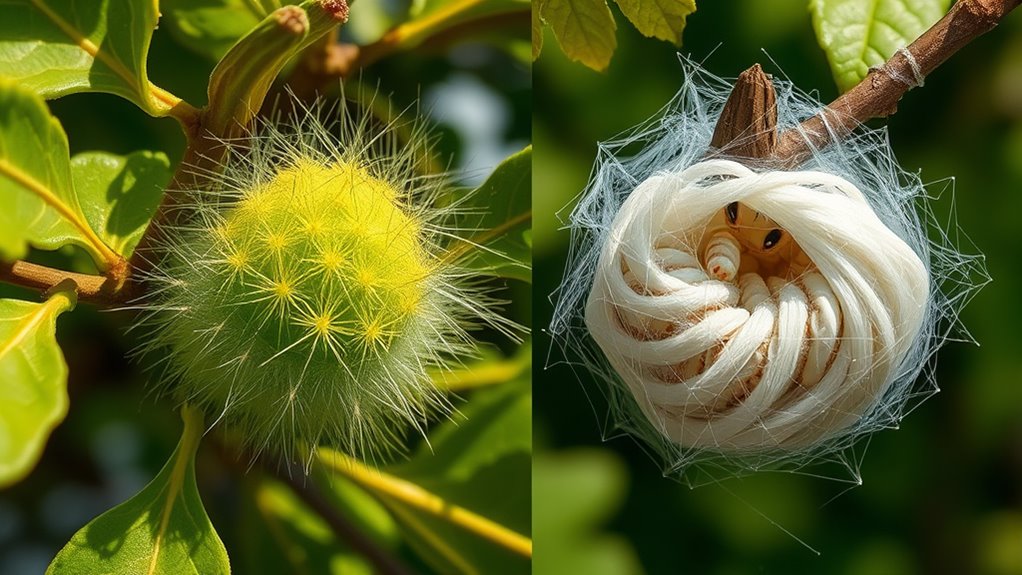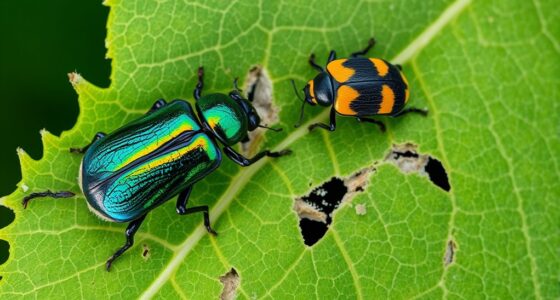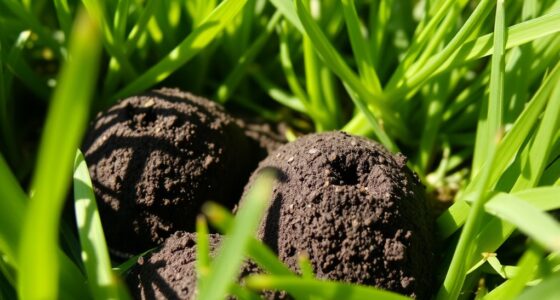Eastern Tent Caterpillars and Fall Webworms create silk structures on trees, but they differ quite a bit. Tent caterpillars form small, tent-like nests in branch forks during early spring, while fall webworms produce large, web enclosures around branch tips in late summer. Their life cycles, web size, and feeding habits vary, so correctly identifying them helps you choose the right control methods. Keep exploring to learn how to tell them apart and manage these pests effectively.
Key Takeaways
- Eastern Tent Caterpillars build small tents in branch forks, while Fall Webworms create large webs enclosing multiple leaves and branch tips.
- Eggs of Eastern Tent Caterpillars are laid in late summer or fall, hatch in early spring; Fall Webworm eggs are laid in late summer, hatch immediately.
- Eastern Tent Caterpillars typically have one generation per year; Fall Webworms can have multiple generations in a season.
- Control involves removing tents or webs, applying biological treatments like Bt or neem oil during larval stages, and promoting natural predators.
- Fall Webworm webs are more visible and larger, making them easier to spot and manage compared to the smaller, less conspicuous tents of Eastern Tent Caterpillars.

When it comes to identifying common tree pests, the Eastern Tent Caterpillar and Fall Webworm often cause confusion due to their similar appearances and behaviors. Both pests create silk nests on trees, but they have distinct differences in their life cycles and control methods that can help you tell them apart and manage them effectively. Understanding their life cycle is essential because it influences the timing and approach of control strategies. The Eastern Tent Caterpillar begins as eggs laid on twigs in late summer or fall. These eggs hatch in early spring, and the caterpillars quickly start feeding on the leaves. During this period, they construct characteristic tents in the forks of branches, which serve as their shelter. The caterpillars grow rapidly, molting several times, and eventually pupate in the soil. Adults emerge as moths in late spring to early summer, completing their life cycle in about a year. Control methods for Eastern Tent Caterpillars include physically removing the tents when they are small, applying Bacillus thuringiensis (Bt) during the caterpillars’ feeding phase, and encouraging natural predators like birds. Since their activity peaks in spring, early intervention is most effective. Monitoring for signs, such as the presence of tents and caterpillars on the tree, is crucial for effective management.
In contrast, the Fall Webworm’s life cycle begins with eggs laid on the underside of leaves in late summer. The larvae hatch and immediately start feeding, spinning webs around the tree’s outer branches. Unlike the Eastern Tent Caterpillar, the Fall Webworm’s web encloses multiple leaves and sometimes entire branch tips, making it more visible. The larvae grow through several instars, feeding within their silk web, which provides shelter from predators and weather. They pupate inside the web or on the branch, and adult moths emerge in late summer to early fall. The entire life cycle from egg to adult spans roughly six to eight weeks, allowing for multiple generations in a single season in warmer climates. Control methods for Fall Webworms involve physically removing the webs, pruning heavily infested branches, or applying insecticidal sprays like neem oil or insecticidal soap during larval stages. Since the webs are conspicuous, timely removal is straightforward and effective.
Frequently Asked Questions
Are Eastern Tent Caterpillars Harmful to Humans or Pets?
Eastern tent caterpillars aren’t harmful to humans or pets directly, but if you or your pets have a caterpillar allergy, you should avoid contact. The caterpillars can cause skin irritation or allergic reactions in sensitive individuals. For pet safety, keep your pets away from the caterpillars and their webs, as ingesting or biting into them could cause discomfort. Always supervise your pets around caterpillars to prevent any accidental bites or ingestion.
Can Fall Webworms Damage Mature Trees Significantly?
Fall webworms can damage mature trees considerably if an infestation becomes severe. You might notice signs like webbed branches or defoliation, which indicate compromised tree health. While a light infestation may not cause lasting harm, extensive webbing and leaf loss weaken the tree, making it vulnerable to pests and diseases. Regularly inspecting your trees helps catch early signs of infestation, protecting their overall health and longevity.
What Natural Predators Help Control These Caterpillars?
You can rely on natural predator control to manage these caterpillars effectively. Birds, such as chickadees and warblers, feed on them, naturally reducing their numbers. Parasitic wasps and flies also help by laying eggs inside the caterpillars, leading to their decline. Incorporating biological pest management encourages these predators, minimizing chemical use and promoting a balanced ecosystem that keeps caterpillar populations in check naturally.
How Do I Prevent Infestations of Either Pest?
Think of your garden as a fortress; you can keep pests at bay with strategic defenses. Use biological control, like encouraging natural predators, and apply organic pesticides early before the infestations take hold. Regularly inspect your trees for early signs of webbing or caterpillars, and remove them by hand. Combining these tactics creates a resilient shield, turning your landscape into a pest-free sanctuary.
Are There Eco-Friendly Methods to Remove Their Nests?
Yes, you can remove their nests eco-friendly by using biological control methods like encouraging natural predators such as birds and parasitic wasps. You can also try homemade remedies like spraying the nests with a mixture of soap and water or neem oil to deter the pests. Always wear gloves and handle nests carefully to avoid disturbing beneficial insects and to keep yourself safe during removal.
Conclusion
Now that you know the key differences between the eastern tent caterpillar and fall webworm, you can spot them in your own yard. Remember, each has its own unique habits—like the fall webworm’s tendency to spin large, unsightly webs, much like a modern-day web developer. By staying vigilant, you can protect your trees and keep your landscape looking pristine. So, don’t be caught flat-footed—stay informed and act early, just like a savvy gardener of yore.









